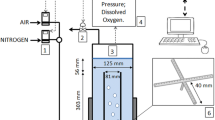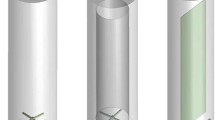Abstract
Study of the distribution of the oxygen mass transfer coefficient, k l a, for a stirred bioreactor and simulated (pseudoplastic solutions of carboxymethylcellulose sodium salt) bacterial (P. shermanii), yeast (S. cerevisiae), and fungal (P. chrysogenum free mycelia) broths indicated significant variation of transfer rate with bioreactor height. The magnitude of the influence of the considered factors differed from one region to another. As a consequence of cell adsorption to bubble surface, the results indicated the impossibility of achieving a uniform oxygen transfer rate throughout the whole bulk of the microbial broth, even when respecting the conditions for uniform mixing. Owing to the different affinity of biomass for bubble surface, the positive influence of power input on k l a is more important for fungal broths, while increasing aeration is favorable only for simulated, bacterial and yeast broths. The influence of the considered factors on k l a were included in mathematical correlations established based on experimental data. For all considered positions, the proposed equations for real broths have the general expression \( k_{\rm l} a = \alpha C_{\rm X}^{\beta } \left( {{\frac{{P_{\rm a} }}{V}}} \right)^{\gamma } v_{\rm S}^{\delta } , \) exhibiting good agreement with experimental results (with maximum deviations of ±10.7% for simulated broths, ±8.4% for P. shermanii, ±9.3% for S. cerevisiae, and ±6.6% for P. chrysogenum).












Similar content being viewed by others
Abbreviations
- C X :
-
Biomass concentration, g/l d.w.
- \( {E}_{{{\text{O}}_{2} }} \) :
-
Oxygen mass transfer efficiency, m3/J
- k l a :
-
Oxygen mass transfer coefficient, /s
- P a :
-
Power consumption for mixing of aerated broths, W
- Pa/V:
-
Specific power input, W/m3
- v S :
-
Superficial air velocity, m/s
- V :
-
Volume of medium, m3
- η a :
-
Apparent viscosity, Pa s
- α, β, γ, δ:
References
Aiba S, Humphrey AE, Millis NF (1973) Biochemical engineering. Academic, New York
Bakker A, Van Den Akker HEA (1994) Gas-liquid contacting with axial flow impellers. Chemical engineering research and design. Trans I Chem E Part A 72:573–582
Bujalski JM (2003) Ph.D. thesis, University of Birmingham
Caşcaval D, Galaction AI, Folescu E, Turnea M (2006) Comparative study on the effects of n-dodecane addition on oxygen transfer in stirred bioreactors for simulated, bacterial and yeasts broths. Biochem Eng J 31:56–66
Caşcaval D, Galaction AI, Turnea M (2007) Comparative analysis of mixing distribution in aerobic stirred bioreactor for simulated, yeasts and fungus broths. J Ind Microbiol Biotechnol 34:35–47
Chisti Y, Jauregui-Haza UJ (2002) Oxygen transfer and mixing in mechanically agitated airlift bioreactors. Biochem Eng J 10:143–153
Galaction AI, Caşcaval D, Oniscu C, Turnea M (2004) Prediction of oxygen transfer coefficients in stirred bioreactors for bacteria, yeasts and fungus broths. Biochem Eng J 20:85–94
Hjertager BH (1998) Computational fluid dynamics (CFD) analysis of multiphase chemical reactor. Trends Chem Eng 4:45–92
Ho CS, Olshue JY (1987) Biotechnology processes scale-up and mixing. American Institute of Chemical Engineering, New York
Ju LK, Sundararajan A (1994) The effects of cells on oxygen transfer in bioreactors: physical presence of cells as solid particles. Chem Eng J 56:B15–B22
Kerdouss F, Bannari A, Proulx P (2006) CFD modeling of gas dispersion and bubble size in a double turbine stirred tank. Chem Eng Sci 61:3313–3322
Kerdouss F, Bannari A, Proulx P, Bannari R, Skrga M, Labrecque Y (2007) Two-phase mass transfer coefficients prediction in a bioreactor with a CFD model. Comput Chem Eng. doi:10.1016/j.compchemeng.2007.10.010
Lane GL, Schwarz MP, Evans GM (2002) Predicting gas-liquid flow in a mechanically stirred tank. Appl Math Model 26:223–235
Lane GL, Schwarz MP, Evans GM (2005) Numerical modeling of gas-liquid flow in stirred tanks. Chem Eng Sci 60:2203–2214
Montes FY, Catalan J, Galan MA (1999) Prediction of kLa in yeasts broths. Proc Biochem 34:549–555
Moo-Young M, Cooney CL, Humphrey AE (1985) Comprehensive biotechnology, vol 2. Pergamon, Oxford
Miyachi M, Iguchi A, Uchida S, Koide K (1981) Effect of solid particles in liquid-phase on liquid-side mass transfer coefficient. Can J Chem Eng 59:640–645
Oniscu C, Galaction AI, Caşcaval D, Ungureanu F (2002) Modeling of mixing in stirred bioreactors. 2. Mixing time for non-aerated fermentation broths. Biochem Eng J 12:61–69
Ozbek B, Gayik S (2001) The studies on the oxygen mass transfer coefficient in a bioreactor. Proc Biochem 36:729–741
Puthli MS, Rathod VK, Pandit AB (2006) Optimization of lipase production in a triple impeller bioreactor. Biochem Eng J 27:287–294
van’t Riet K, Tramper J (1991) Basic bioreactor design. M. Dekker, New York
Weber ME, Paddock D (1983) Interceptional and gravitational collision efficiencies for single collectors at intermediate Reynolds numbers. J Colloid Interface Sci 94:328–335
Author information
Authors and Affiliations
Corresponding author
Rights and permissions
About this article
Cite this article
Caşcaval, D., Galaction, AI. & Turnea, M. Comparative analysis of oxygen transfer rate distribution in stirred bioreactor for simulated and real fermentation broths. J Ind Microbiol Biotechnol 38, 1449–1466 (2011). https://doi.org/10.1007/s10295-010-0930-3
Received:
Accepted:
Published:
Issue Date:
DOI: https://doi.org/10.1007/s10295-010-0930-3




